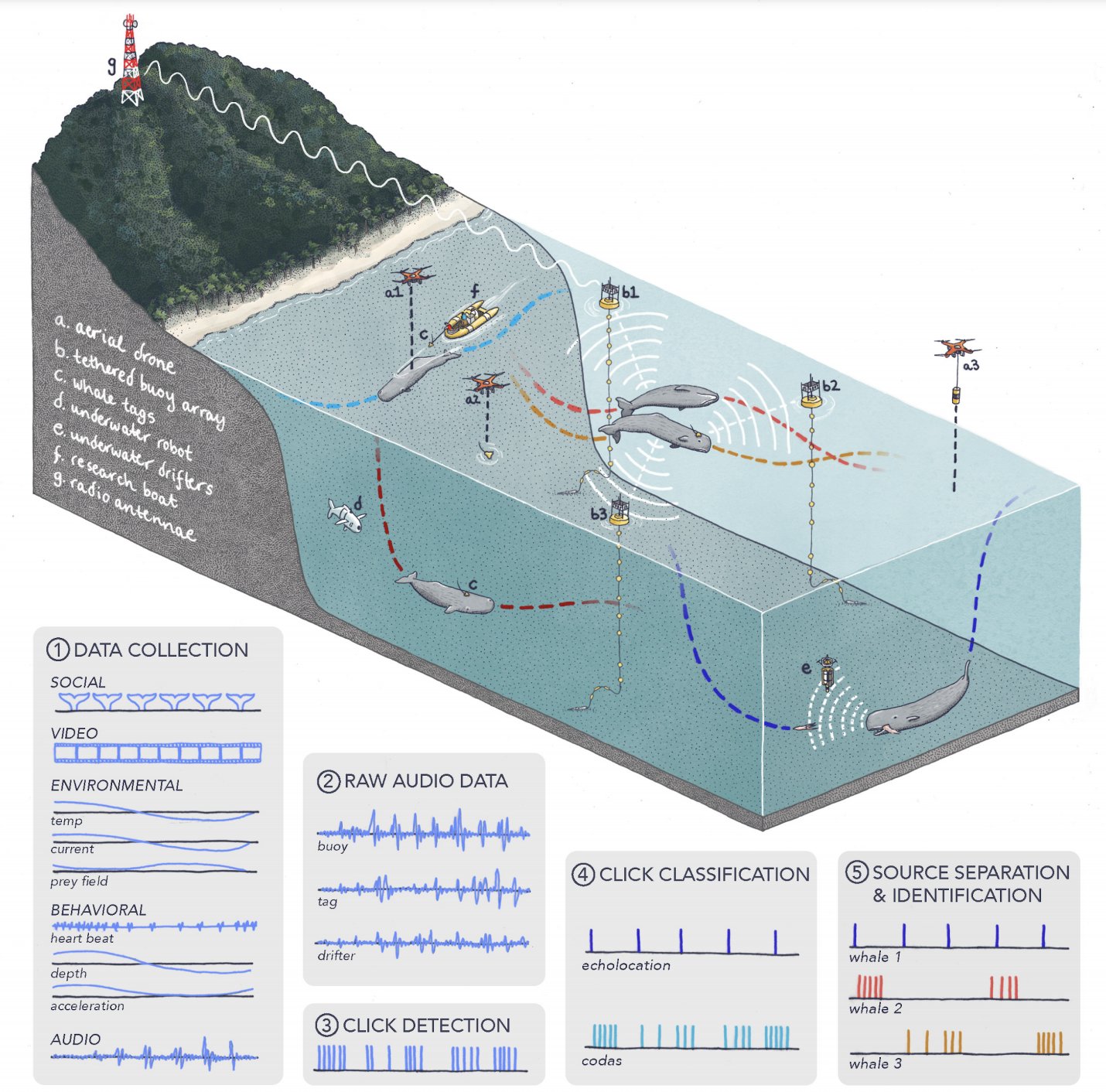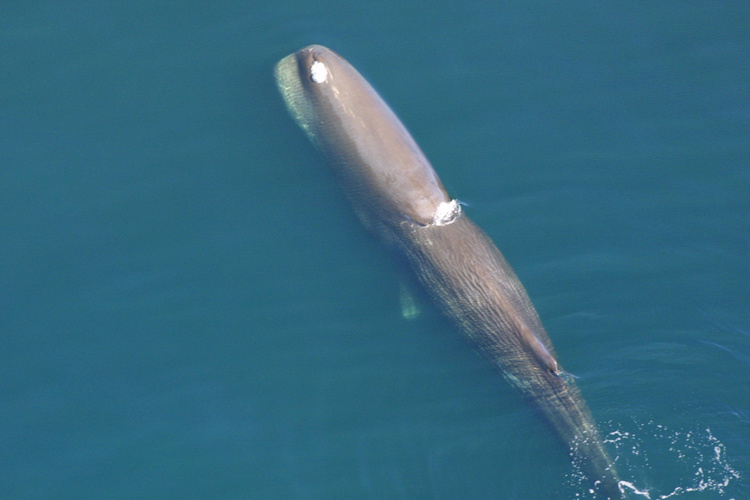
Credit: Gabriel Baratheiu, CC BY-SA 2.0, via Wikimedia Commons
Background
Synopsis: Animals communicate in a variety of ways both verbal and non-verbal. From the dance of honeybees, the howling of wolves, the purr of a kitten, or the light of a firefly, we consider these as simple ways that animals convey messages to one another. Advanced speech was thought to be reserved for the higher intellect of humans, but new research, with the help of artificial intelligence, suggests that some whales might also exhibit complex language.
Whales in Human Culture
- From the biblical story of Jonah and the whale to the classic story of Moby Dick, humans have long held a fascination with whales.
- In many cultures, whales have been viewed as symbols of power, intellect and harmony with nature. In other cultures, they are a source of life with ritualistic hunting ceremonies and reverence for the whale spirit.
- A very different relationship was evident when large-scale commercial whaling in the mid-20th century drastically reduced the global whale population as whales were killed in vast numbers for their meat and oil.
Whale Conservation Efforts
- Efforts to save a dwindling whale population began in the early 1970s after marine biologist Roger Payne recorded the deep melodic sounds of whales and produced an album, Songs of the Humpback Whale, which was an unexpected hit and has reached multi-platinum status.
- The recording served as the anthem for whale conservation and led to the passing of the Marine Mammal Protection Act which prohibited the intentional killing of whales, sharks, dolphins, sea lions, and other marine mammals.
- Payne’s efforts also resulted in the establishment of Project CETI (Cetacean Translation Initiative), an assemblage of marine biologists, linguists, artificial intelligence experts, roboticists, and underwater acoustic experts from academia and the private sector.
- The non-profit’s goal is to not only lead conservation efforts but to also use sophisticated machine learning to decipher the communication of whales.
Mission of Project CETI
- Project CETI’s overall mission is to translate how other species communicate. They started this undertaking with sperm whales.
- The group has focused their effort on a group of sperm whales (Physeter macrocephalus) located in the Caribbean. The clan under study resides close to the island of Domenica and comprises about 300 sperm whales.
- Sperm whales are the largest toothed whale with females growing to an average of 40 feet (12 meters) and 15 tons, while males average 52 feet (16 meters) and 45 tons. They live in deep waters and feed on squid, skates, sharks and other fish and are found in oceans across the globe with a total population estimated to be around 300,000.
- Sperm whales have the largest brain of any known animal and exhibit complex societal relationships within and between families and groups.
Decoding Whale Communication
- The first step in understanding the sperm whale’s communication was data collection. Recording devices were affixed using suction cups to approximately sixty whales from the group.
- Over several years, they amassed a collection of over 9000 whale calls, each consisting of a series of clicks.
- To generate the clicking noise, air is pushed through the whale’s nasal passages at high-pressure, vibrating a structure in the nose called the phonic lips. When the lips come back together, a click is made. The sound is amplified by the large fatty structure in their heads, called the spermaceti organ.
- These same clicking noises are also used for echolocation which aids in navigation and finding prey. (ED71 – The Curious Tale of Whales)
- The challenge for Project CETI was to figure out what patterns exist in these clicks and what they might mean for communication.

Air is pushed out through the blowhole and then vibrates the small structure called the phonic lips to create the clicking sounds.
Credit: Jooja, CC BY-SA 4.0, via Wikimedia Commons
Using AI for Analysis
- Project CETI partnered with MIT CSAIL (Computer Science and Artificial Intelligence Laboratory) and used machine learning to uncover identifying features of communication within the recordings.
- The sperm whales typically made bursts of short clicks which they called codas. The codas varied from three to forty clicks in length and last a mere 2 seconds.
- Artificial intelligence also recognized that the whales could speed up or slow down the tempo of the codas which the team dubbed the rubato. This could be compared to music that is played slowly for a gentle effect or faster for a dramatic effect. In human speech, we might pause or speed up when we talk to convey excitement, suspense, or importance.
- Another feature recognized was an extra click at the start or end of some codas that they called the ornamentation. This would be analogous to a singer adding an extra trill or note at the end of a song or, as in speech, adding a deliberate “um” or an emphatic “tsk” at the end of a sentence.
- These extra clicks on a coda may indicate when whales take turns listening and speaking. Humans use something similar when speaking on a telephone, starting with “hello” and ending with “goodbye.”
- With the variations in codas, rubato, and ornamentation, researchers estimate that, what was thought to be 21 different codas, could potentially combine to form several hundred possible click patterns. However, the data and analysis from the Eastern Caribbean sperm whales revealed 156 unique patterns.
- These distinctive patterns may be the basis of a sperm whale “phonetic alphabet” that will direct further research on the communication patterns. How might these distinct codas be used by sperm whales to indicate danger, prey or location?
- Next steps include more data collection that involves both sound and sight. The team hopes to put cameras and recording devices on some of the whales to learn if specific codas are used during hunting, navigation, and even mating. By combining the audio with visual data, the full meaning of the sounds may be decoded.

With a host of partners, Project CETI studies not only the audio but behavioral and social lives of the Domenica sperm whales using a wide variety of tools and technologies.
Credit: A. Conner-Simons/MIT CSAIL
Lessons in Communication
- Decoding the clicks and codas of sperm whales has opened a window into the sophisticated ways these animals communicate. By combining technology, linguistics, and biology, researchers are uncovering a phonetic alphabet that could deepen our understanding of not only whales but also the evolution of complex communication in the animal kingdom. This research reminds us that intelligent life may use unexpected methods to connect, inspiring us to explore how understanding such systems might one day extend to communication beyond Earth.

Sperm whales usually prefer deep water, but here is a rare glimpse of one at the surface.
Credit: NOAA Fisheries
Episode script
In the 1970s, Roger Payne had a multi-platinum record, a surprise hit for two big reasons: Payne was a marine biologist, not a musician. And the singers on the album… were whales.
Payne’s “Songs of the Humpback Whale” revealed that other creatures may have complex language. It raised interest in whale intelligence, and led to the passage of laws protecting them.
It also encouraged scientists from many different fields to try to figure out what the whales are saying.
Project CETI has been studying the dialogue of a clan of sperm whales in the Caribbean for many years.
Sperm whales communicate with rapid clicks, produced by blowing pressurized air through their nasal cavities, which is then amplified by a resonating organ in their heads.
They can vary the number and tempo of the clicks to form complex streams.
Scientists recorded thousands of click streams, then used machine learning to uncover 156 patterns shared by individuals in the clan – like a vocabulary of whale words.
However, they still have no idea what these words could mean. So, the next step is to attach cameras to the whales to try to connect actions to the words.
If they can understand this whale clan’s vocabulary, they may be able to communicate with them…
And perhaps decipher the language of other whales, other lifeforms on Earth, maybe even signals from beyond our planet.

